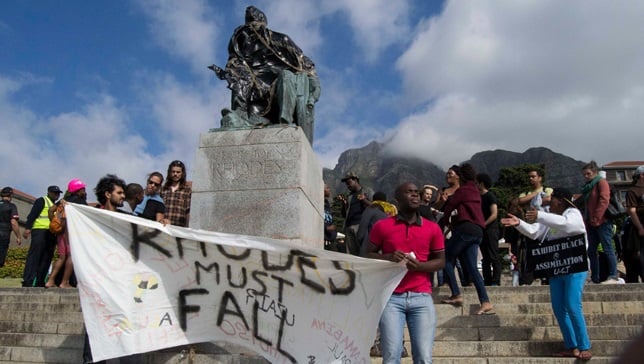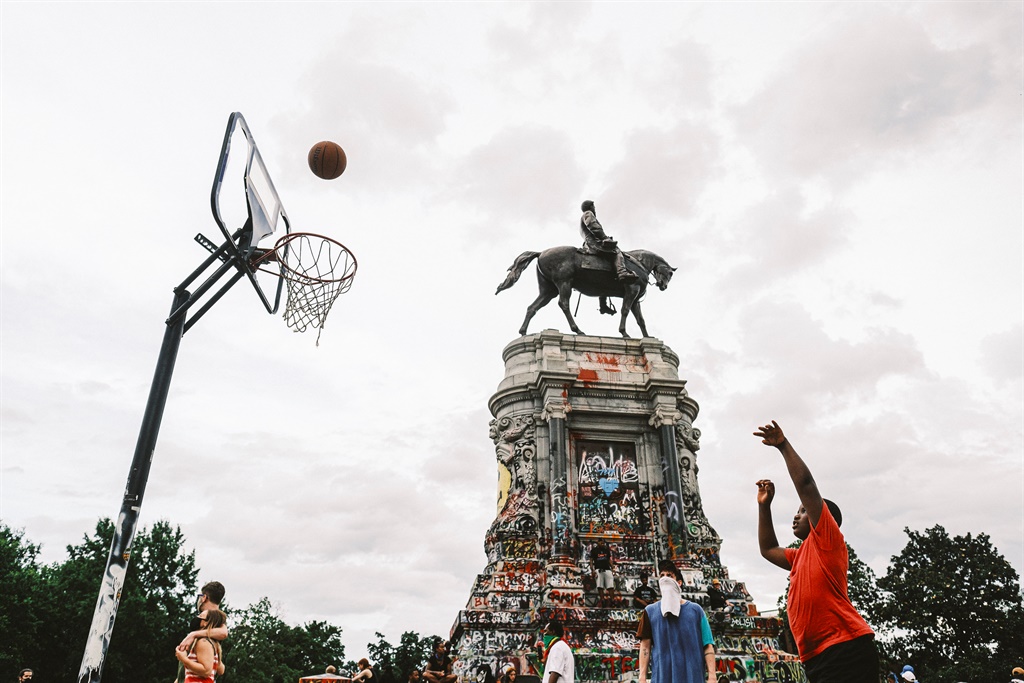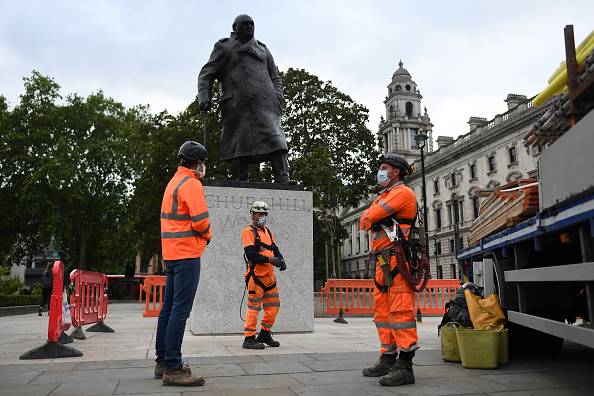Whatever we do with contentious or controversial statues and monuments, it should not be the outcome of the random acts of populist mobilisation. Building inclusive societies is the result of thoughtful and collective deliberation, argue Adam Habib and Alexandra Leisegang.
Statues across the world are being torn down, vandalised, in response to legitimate anger about racism and historical oppression which continue to manifest in our world.
Initially, the focus was on the statues of slave traders but it soon broadened to incorporate conservative politicians, industrialists, philanthropists and others associated with the colonial project. We hold no truck for these historical figures, given our respective political track records and ideological orientations.
But whatever one’s ideological orientation, questions have to be asked about these attacks on statues. Who decides which ones fall and those that stand? What are the public deliberations that underlie these decisions, and what are the legitimate parameters on making judgements on historical figures?



The statue of British imperialist Cecil John Rhodes before its removal at the University of Cape Town. (Media24 Archives.)
Questions also have to be raised on how the space for debate on these issues is quickly being closed down by a self-appointed political vanguard who unilaterally have abrogated the responsibility to make decisions that is the collective responsibility of society. These are uncomfortable questions but they are necessary to address, so that political precedents are not established in our society that may come to haunt us in the future.
Too many historical figures who plundered are still revered
There is a legitimacy to the anger about statues.
Too many historical figures, who plundered and murdered black and indigenous peoples, are now honoured and given respectability, which is an insult to their victims and descendants. This situation has to change. But how we go about it is important, as are the public messages that we want to collectively communicate.
Statues and memorials are often established to honour individuals. But they can also be conceptualised, designed and constructed to extend historical memory and inform public consciousness, so that some experiences are never repeated. This is more than simply learning history in a narrow sense; it is really about public conscientisation and the transmission of values and memory from one historical epoch to another.
The best example of this are the countless memorials for the Holocaust and other genocides across the globe as a reminder that this must never happen again. These memorials have been established to honour victims, and to tell their stories. Why can we not reimagine statues and monuments in the same way; as a thoughtful lesson rather than a celebration of these individuals?
We also should be careful of making easy judgements on individuals outside of their historical context.
Some acts are so vile that they must be condemned across the historical divide. But others may be unacceptable today, yet were typical in another historical moment.
What does one do with the likes of Churchill, Washington, and Jefferson? The former was a conservative politician, who held some abhorrent views, but his tenacity won a war against Fascism. The latter were slave owners, but gave birth to a nation that today is a superpower.
How many progressive thinkers and anti-colonial fighters harboured patriarchal views? If certain progressive heroes were alive today, would they survive the #MeToo movement? Likely not. Are we going to destroy monuments of them in this popular rage or will we understand them as products of their historical moment?



The defaced statue of Confederate general Robert E. Lee in Richmond, Virginia, in the United States. (Gallo Images.)
None of this suggests that statues must not fall. What is being insisted on is that, whatever the decision, it must be the product of a public deliberation. In such deliberations, three options should be considered; removing a statue, reimagining it, or leaving it as is.
Statues of historical figures, who we collectively deem as products of their historical moment and that do not repulse us as a society, should be allowed to survive. There may also be some statues of historical figures which we may proactively commission because we want to honour them for their contribution to improving our world. But there will be other statues of historical figures, whose hurtful or vile actions transcend the historical divide and may be considered for removal or reimagination. This must be determined on the basis of the specific action of the historical figure and the need to publicly conscientise or communicate a historical lesson.
There are certainly some statues that should be removed, but this must be done through a deliberative process in line with our democratic values as a society. The removal of such a statue should also not undermine or impinge on the need to publicly conscientise in relation to a historical event or incident. But where a statue may be valuable in conscientising the public, then we should be open to keeping it, but reimagining and redesigning it to communicate an alternative public message.
Let us identify three examples of such reimagination.
What to do about controversial statues, monuments?
The first of this was brought to our attention by Palesa Morudu in a twitter conversation, in which she highlighted a discussion around the removal of Robert Lee’s statue and the power of an empty space. We agree with this, but the message communicated by the empty space can only be time abound. As soon as the memory of the incident recedes, the power of the imagery itself erodes.
A second more powerful reimagination in our view was that illustrated by Banksy, through his re-articulation of the Edward Colston statue, which remained in place but with protesters pulling it down. This is a public messaging that could be enormously powerful; communicating a history of a city built through the slave trade, but subsequently redefining itself when future generations protested that offensive tradition.
A third example could have been the Rhodes statue at the University of Cape Town.
The student protest of 2015 around #RhodesMustFall was successful in bringing down the statue, but it was not the first time that such a call had been made. Back in the 1950s, Afrikaans students had wanted it removed because it symbolised British colonial rule and the oppression of Afrikaners. They were unsuccessful, but the students that followed them 60 years later fought the same battle (on the same grounds) and won.
The space where the Rhodes statue stood remains empty since the protests. A decision was made to rename the Jameson Memorial Hall to the Sarah Baartman Hall. However, this decision does not speak to UCT’s own history with Rhodes – it just erases his presence on campus instead of speaking to why he was commemorated there in the first place.



The statue of wartime British prime minister Winston Churchill on Parliament Square in London after being spray painted recently. (Media24 Archives.)
There could have been another possibility with the Rhodes statue. What if the university had the courage to commission an artist to reimagine the statue as part of a broader ensemble of casts involving victims of the actions of Rhodes? Such a redesign could have communicated the public message that Rhodes’ wealth and philanthropy were built on the blood, sweat and tears of generations of black and Afrikaner families.
It would have been a powerful, progressive monument reminding UCT students every day about the exploitation that had enabled the birth of the institution, and implicitly requiring them to commit their knowledge and skills to transform their society for the better of all.
Offensive statues can present an opportunity
Statues and monuments are not only there to celebrate historical figures. They could also be constructed to record historical events and ensure that we tell the stories of our past – either as a warning to future generations or an opportunity to provide a fuller account of history in the public consciousness.
Should we then not consider the reimagination of statues and memorials as one option among others, to honour and tell the story from the perspective of victims? This would be a moment for our artists to use their creativity to redefine how we deal with our past, in a way that reflects the present and a more tolerant, inclusive future.
No matter which option is decided on about how to treat statues and monuments, it must result from a deliberative exercise in society. It should not be the outcome of the random acts of populist mobilisation. Building inclusive societies is the result of thoughtful and collective deliberation. It cannot be from the actions of the loudest and the most muscular.
It is worth remembering that it is easy to tear something down, but far more difficult to build a new world which acknowledges and learns from the wrongs of the past.
– Professor Adam Habib is the Vice-Chancellor and Principal of the University of the Witwatersrand and incoming Director of the School of Oriental and African Studies (SOAS).
– Dr Alexandra Leisegang is the Executive Officer to the Vice-Chancellor of the University of the Witwatersrand. They write in their personal capacity.

